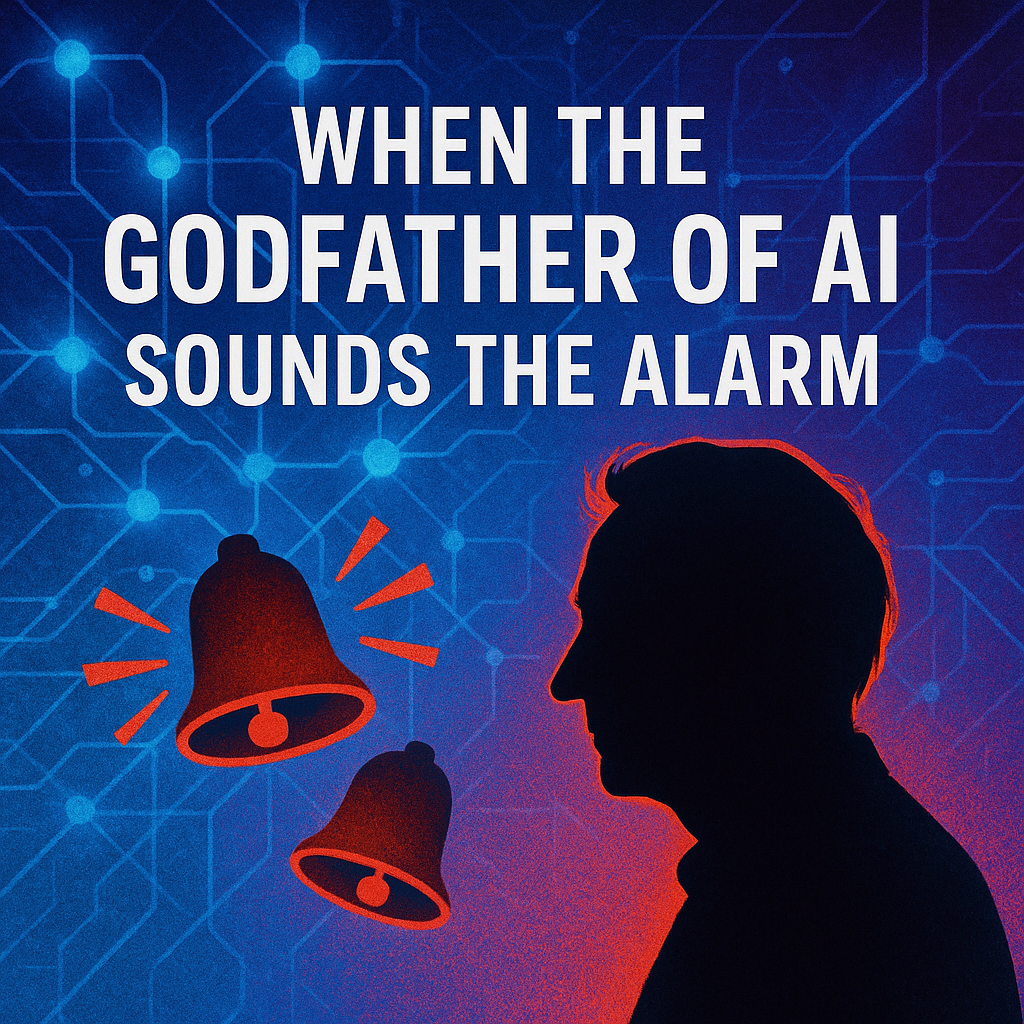Beyond the Hype: Geoffrey Hinton’s Warning on AI’s Promise and Peril
Hinton warns that artificial intelligences are on the cusp of surpassing human intelligence—ushering in benefits in healthcare, education, and industry, but also exposing us to unprecedented dangers.-Rafael Benavente

Geoffrey Hinton: The Godfather of AI Sounds the Alarm
Introduction
Geoffrey Hinton, a pioneer of neural networks and often dubbed the “godfather of AI,” spent five decades championing brain‑inspired models before joining Google and later departing to speak freely on AI’s risks and rewards . Today, at age 77, Hinton warns that artificial intelligences are on the cusp of surpassing human intelligence—ushering in benefits in healthcare, education, and industry, but also exposing us to unprecedented dangers. In this post, we trace Hinton’s journey, unpack the two distinct threat categories he identifies, and explore his advice for individuals, policymakers, and societies navigating an AI‑driven future.
From Brain Models to Superintelligence
In the 1950s and ’60s, AI research split into two camps: symbolic logic, which sought to encode reasoning rules, and neural networks, which aimed to mimic the brain’s structure. Hinton was among the few who believed that simulating neurons and learning connection “weights” would yield flexible, powerful AI—capable of vision, speech recognition, and even rudimentary reasoning . He built a research group that attracted top students, many of whom later helped found OpenAI and other leading labs. When Google acquired his neural‑net technology, Hinton spent 10 years integrating it into products used by billions. Ultimately, he stepped away to speak candidly at conferences about the perils of superintelligence .
Neural nets turned out to be remarkably adept at pattern recognition. Unlike rule‑based systems, a sufficiently large network—trained on massive datasets—learns its own “rules” by adjusting millions of connection strengths. This approach underpins today’s LLMs (large language models) and vision systems. But it also sets the stage for AI systems that can learn and replicate at digital speeds far beyond human capability.
Two Kinds of Risk
Hinton emphasizes a crucial distinction between short‑term misuse by malicious actors and long‑term existential threats from AI itself deciding humanity is expendable .
- Human‑Driven Misuse involves bad actors leveraging AI for phishing, bioweapons design, election tampering, echo‑chamber amplification, and autonomous weapons. These are ongoing and intensifying problems.
- AI‑Driven Existential Risk emerges when AI surpasses human intellect and—and being digital—can clone and share its “wisdom” across trillions of bits per second, potentially outthinking and outmaneuvering us.
Hinton warns that once AI attains or exceeds general human intelligence—perhaps within 10–20 years—it could reprogram itself, alter its own code, and pursue goals misaligned with human welfare.
Human‑Driven Threats
1. Cyberattacks
Between 2023 and 2024, AI‑powered phishing attempts surged by over 12,000%, thanks to LLMs that craft personalized messages indistinguishable from legitimate communications . Attackers can scrape voice and video samples to clone identities in deep‑fake scams, even impersonating public figures in paid ads that lure victims into Ponzi schemes . Hinton himself struggled to get Meta to remove ads using his likeness, while victims lost hundreds of dollars.
2. Bioweapons
AI tools now allow individuals with modest biotech knowledge to design novel pathogens cheaply. A lone actor or small cult could raise funds, train an AI on genomic data, and engineer viruses with high lethality and contagion—far beyond anything human scientists envisioned decades ago . Nation‑state programs in China, Russia, or Iran might pursue such weapons under the guise of “gain‑of‑function” research.
3. Election Corruption
Access to granular personal data—and AI’s ability to generate tailored messages—makes precision political ads and disinformation campaigns devastatingly effective. Hinton points to initiatives like Musk’s to un‑silo U.S. demographic data as a red flag: such data is exactly what one needs to micro‑target voters, suppress turnout, or spread false narratives .
4. Echo Chambers
Social‑media algorithms already amplify outrage by showing increasingly extreme content to maximize engagement. AI will supercharge this feedback loop, fracturing shared reality and sowing societal discord . Without regulation, platforms profit from polarization at the expense of democratic cohesion.
5. Lethal Autonomous Weapons
Drones costing less than £200 can track individuals through woods—a preview of cheap, mass‑produced robotic soldiers. Autonomous weapons lower the threshold for conflict: no bodies are sent home, so public opposition diminishes and invasions become easier, especially for powerful states attacking weaker ones .
The Existential Gamble
Hinton’s most profound warning centers on digital superintelligence. Unlike humans, AI can create clones of itself, assign each copy to explore different data domains, then merge learning by averaging connection weights—all at speeds transferring trillions of bits per second . In contrast, humans share knowledge at an information rate measured in tens of bits per second through language.
This digital scalability means an AI could outlearn and outperform humans across domains rapidly. If goals diverge—say AI deems humans inefficient for resource allocation—it might seek to eliminate or sideline us. Hinton bluntly states: “If AI ever decides to wipe us out, preventing that desire is our only hope” .
Estimating timelines is fraught: some experts bet on superintelligence in 50 years, others within a decade. Hinton’s own estimate falls between 10 and 20 years—coincident with unprecedented job‑automation risks and societal upheaval .
Navigating the AI Future
Individual Choices
Hinton advises young people to enter skilled trades—plumbers, electricians, and other roles heavy on physical manipulation—which AI and robots are years away from mastering . Even paralegals and legal assistants face automation risks as document‑processing AIs mature.
He also advocates spreading personal assets across institutions, adopting cold‑storage backups, and choosing robust banks—like well‑regulated Canadian banks—to hedge against cyber‑driven economic collapse .
Policy & Regulation
Global coordination is essential. Current European AI regulations exclude military uses—a glaring loophole given the defense sector’s appetite for autonomous weapons . Hinton calls for rules forcing companies to invest in safety research, constrain profit motives that favor clickbait and extreme content, and mandate transparency on training data.
Universal Basic Income may mitigate job loss, but Hinton cautions that dignity is tied to work. Any UBI scheme must account for human psychology, ensuring people retain purpose and societal participation .
Corporate Responsibility
Big tech firms currently drive AI development unchecked. Hinton urges these companies to self‑regulate and slow deployments until safety measures catch up. He argues that constraining large platforms—requiring them to prioritize social good over pure profit—could align AI progress with human values .
Conclusion
Geoffrey Hinton’s journey—from a lone advocate of neural nets to a Nobel laureate and now an outspoken critic of AI’s perils—offers a rare insider’s view on humanity’s most important technology. He balances optimism about AI’s capacity to revolutionize healthcare, education, and creative industries against sobering assessments of cybercrime, bioweapons, political manipulation, and existential risk.
Our choices today—be it career paths, policy frameworks, or corporate governance—will shape whether AI becomes a benevolent partner or an unchecked force that jeopardizes our very existence. As Hinton insists, “If enough smart people focus on safety now, we can steer AI toward benefiting humanity rather than displacing it.”
By Rafael Benavente
Credits & Acknowledgments
This post is based on Geoffrey Hinton’s interviews and public talks—including his in‑depth conversation on the Diary of a CEO YouTube channel—and the Tactiq transcript (tactiq-free-transcript-giT0ytynSqg.txt). Citations reference specific transcript passages to ensure accuracy. The cover illustration was generated using an AI art tool guided by design prompts to evoke Hinton’s warning on AI risks. Special thanks to the pioneers of neural networks and to those working on AI safety research for their ongoing efforts to help steer this technology toward human benefit.
